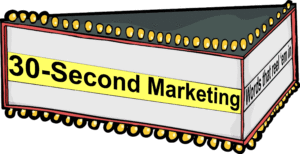
Brand development for coaches, consultants and professionals of all kinds is not easy.
You don’t have big bucks for advertising. You aren’t comfortable “tooting your own horn”. But you have to convince prospects to trust you, hire you and pay you for your services.
You have to talk about yourself.
You have to have a vision, the “why” of your organization even if there is only one of you. You need to spell out your mission so you can stay on track. You need to find the “only” in your practice. But first you have to understand who your potential customers are.
Seven keys to building profiles of the customers for your brand:
- Don’t try to come up with a single profile. It doesn’t work because you know they come to you for different reasons.
- Pick the top three reasons they come to you. Build profiles for each noting the percentage of income each generates for your business. Not enough experience to rate them? Put them in order by your preference. Then talk to folks you think will fit the mold.
- Do the research. Learn as much about them as you can. Have coffee with a few of the individuals that have hired you. Ask them the same questions. Note the similarities.
Get the Profile Checklist. Sign up to get our updates at www.BrandBrainTrust.com
- Determine how many more of them there are within your neighborhood, city, state or region, the geographic area where you are willing to provide your services.
- Estimate the time and cost commitments you will have to make in order to reach them. Time must be estimated because you will probably have to spend time that is not billable to bring this off. Cost of items you absolutely must have should be determined as well. That includes well-designed logotype, business cards, letterhead, web site and social media pages at a minimum.
- Start connecting by networking on and off-line. Attend local chamber and other association meetings they frequent. Become active in groups where they cluster on Linked In, Facebook and in the real world.
- Listen to them first then talk about what you’ve done for others. People want to have a conversation not hear commercials at networking events. Give them the time to tell you what is on their mind. Then if they have a problem you can solve, offer your services. That is the guiding principle of 30-Second Marketing
______________________________________________________________________________
Jerry Fletcher is the founder of www.BrandBrainTrust.com His consulting practice, now in its 26th year, is known for Brand Development, Positioning and business development on and off-line.
Consulting: www.JerryFletcher.com
Speaking: www.NetworkingNinja.com
Get all the Brand Briefs. Sign up at http://www.brandbraintrust.com/home.html


